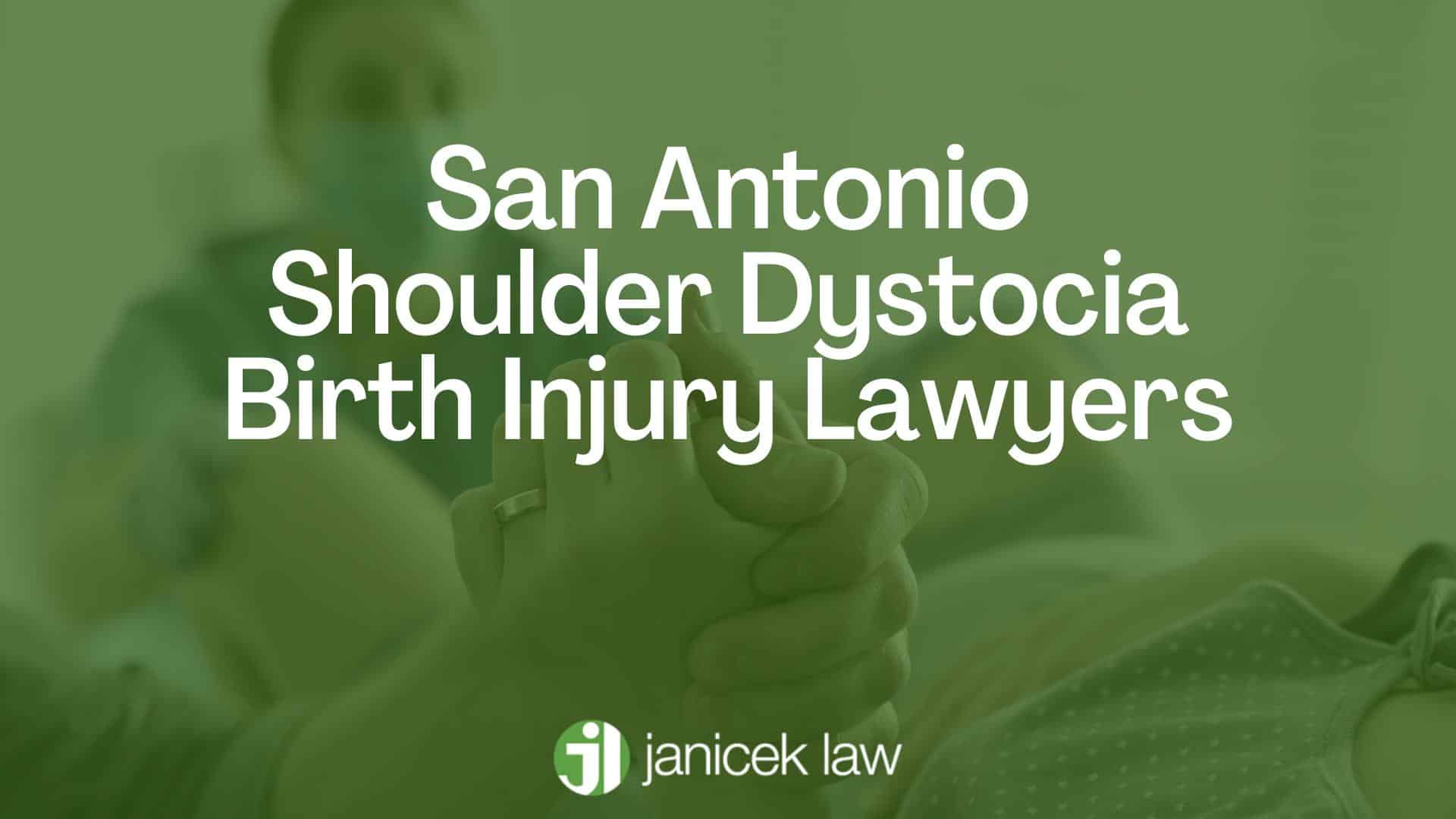San Antonio Shoulder Dystocia Lawyer
Almost 30,000 babies are born with some type of birth injury in the United States annually. 1,168 of those were due to accidents or unintentional injuries. Additionally, shoulder dystocia was recently “identified as the highest contributing risk factor for intrapartum fetal deaths.” If your baby suffered from a shoulder dystocia injury during birth, or if medical malpractice contributed to your baby’s shoulder dystocia death, the San Antonio birth injury lawyers at Janicek Law are ready to fight for your family.
Our San Antonio shoulder dystocia birth injury lawyers have been litigating birth injury claims for over 20 years. Our San Antonio medical malpractice attorneys helped hundreds of clients who were injured by surgical errors, medication errors, anesthesia errors, and more.
Our team of board-certified San Antonio personal injury attorneys has the experience, knowledge, and dedication needed to help you with your birth injury lawsuit. Our law firm works on a contingency fee basis, so you won’t owe any legal fees unless your birth injury lawsuit is successful.
Call 210-366-4949 for a free case review with an experienced shoulder dystocia attorney in San Antonio, TX.
What is Shoulder Dystocia?
Shoulder dystocia occurs when the baby’s head has been delivered, but the baby’s shoulder is stuck behind the mother’s pubic bone.
When this happens, the baby’s body doesn’t slide out after the head without additional actions by the treating physician. Essentially, this means that the baby is stuck inside the birth canal. So, shoulder dystocia can result in serious medical complications for both the mother and the baby.
Shoulder dystocia is an obstetric emergency in which the fetus’s head doesn’t lead to the delivery of the shoulders. This can cause brachial plexus injury, hypoxia, and maternal trauma, such as damage to the bladder, rectum, and anal sphincter. Mothers can also endure postpartum hemorrhage from this birth injury.
Contact our San Antonio maternal birth injury attorney team to learn more.
Shoulder Dystocia Birth Injury Risk Factors
Shoulder dystocia occurs in approximately 0.2-0.3% of pregnancies, and shoulder dystocia death occurs in approximately 0.4% of birth traumas. While the birth injury is uncommon, it isn’t unheard of. The lasting effects of shoulder dystocia demand that physicians closely monitor warning signs leading up to delivery.
Like most birth injuries, shoulder dystocia can affect any family. However, some women are more at risk for this specific birth injury compared to others.
Maternal Birth Injury Risk Factors
Risk factors most commonly associated with shoulder dystocia that are specific to the mother:

Macrosomia occurs when a baby weighs over 8 pounds, 13 ounces. While most vaginally delivered babies born with macrosomia don’t experience shoulder dystocia, a large baby will raise the risk factors, as mothers have more difficulty delivering large babies.
If the mother gains too much weight during her pregnancy, this can be another risk factor for shoulder dystocia.
If the mother has preexisting diabetes or if the mother develops gestational diabetes, this increases the chances of the birth injury.
Most of the time, doctors won’t opt for a vaginal delivery for twins. The risk factors associated with this type of delivery are too high. Mothers who want to vaginally deliver multiple babies are at an increased risk for at least one of the babies experiencing shoulder dystocia.
If a mother has previously delivered a baby that suffered from shoulder dystocia, the chances of the birth injury occurring again are high.
Birth Injury Risk Factors in the Delivery Room
Other risk factors most commonly associated with shoulder dystocia that are specific to the labor conditions:
- Having labor induced by oxytocin.
- Receiving an epidural to reduce pain during labor and delivery.
- Having a shorter or longer second stage of labor. (The second stage of labor is when the mother begins to push).
While the aforementioned risks can increase the chances of birth injuries, such as shoulder dystocia, one of the largest contributors to this specific birth injury is having an assisted vaginal delivery or operative vaginal birth.
In an assisted vaginal delivery, the physician will use medical tools to pull the baby through the birth canal. In some assisted deliveries, the doctor will use forceps to gently guide the baby through the birth canal. While in other assisted deliveries, the doctor will use a medical vacuum to suction the baby out.
Shoulder Dystocia Symptoms
The most common symptoms of this birth injury include:
- Retracting difficulty
- Fetal head restitution failure
- Difficulty delivering the baby’s face and chin
- Downward traction on the fetal head
- Inability to deliver the baby’s shoulders

Shoulder Dystocia Birth Injury Complications
Many mothers and babies can recover fully from this birth injury. However, some children or mothers will face the following complications after labor and delivery:
Shoulder Dystocia Birth Injury Complications for Baby
- Fracture in the baby’s collarbone or arm
- Inability for the baby to expand its chest
- Contusions
- Lacerations
- as well as the following:
Umbilical Cord Compression
Brachial Plexus Palsy
Brachial plexus nerves extend from the baby’s spinal cord to the baby’s arm and neck. This nerve damage can cause the baby to suffer from Erb’s Palsy (when the upper brachial plexus area is paralyzed) or Klumpke’s Palsy (when the lower brachial plexus is paralyzed).
Contact our San Antonio brachial plexus injury attorney group to learn more.
Oxygen Deprivation
If the baby is deprived of enough oxygen, this can lead to a brain injury or shoulder dystocia death.
Contact our San Antonio brain injury lawyers for a free consultation.
Pneumothorax
This is a collection of gas between the baby’s chest wall and the baby’s lungs.
Cerebral Palsy
Shoulder Dystocia Birth Injury Complications for The Mother
- Symphyseal separation which leads to excessive movement around the pelvic bone.
- Sacroiliac joint dislocation
- Cervical tears
- Uterine or bladder rupture
- Postpartum hemorrhage
- Severe perineum tears
Shoulder Dystocia Birth Injury Prevention
It is the OB-GYN’s responsibility to monitor the mother throughout the pregnancy and to look for potential delivery complications. The OB-GYN should be aware of the maternal risk factors long before the delivery date arrives. If the mother presents with all of the common risks for this birth injury, the doctor should advise her to schedule a c-section well before giving birth. As a healthcare provider, it is the OB-GYN’s job to weigh the risks and make an informed decision for each patient.
However, if the mother shows no warning signs leading up to the delivery, during the delivery, the OB-GYN has several options to help prevent shoulder dystocia.
During the medical emergency, the doctor or medical team may:
- Use the McRoberts maneuver, a maneuver in which the mother presses her thighs against her stomach.
- Apply suprapubic pressure. This is where the doctor or nurse presses on the mother’s lower belly, right above the pelvic bone.
- Reach into the vagina and attempt to turn the baby.
- Physically help the baby’s arm out of the mother’s birth canal.
- Ask the mother to get on all fours in an attempt to turn the baby.
- Give an episiotomy. This is a surgical cut at the vaginal opening.
- Perform an emergency c-section.
Contact our San Antonio hospital negligence lawyers for a free birth injury consultation.

Birth Injury Lawsuit for Shoulder Dystocia Injuries
Doctors, nurses, hospitals, and other healthcare providers have a duty to provide a safe environment for both the mother and the baby during labor and delivery. And, while some tragedies can occur regardless of how careful any medical professional is, some birth injuries occur as a direct result of medical negligence or medical malpractice.
As previously stated, the treating physician should know the common risks for shoulder dystocia and should be aware of all maternal risks well before the delivery date. At the very minimum, the OB-GYN should have discussed the risks of a vaginal delivery, even with proper care, including increased risks of brain damage, Cerebral Palsy, and other injuries for the baby, as well as the increased risks for the mother.
If the treating physician doesn’t take preventative measures to minimize the risk of shoulder dystocia, or if he or she does not act both quickly and properly in response to the shoulder dystocia, then you may be able to pursue financial compensation through a medical malpractice lawsuit.
Generally, physicians can face two types of medical malpractice lawsuits associated with shoulder dystocia birth injury cases:
Failure to Diagnose or Expect Shoulder Dystocia
A doctor can be held liable through a birth injury lawsuit if he or she was aware of the risk factors and chose not to change delivery plans. This medical malpractice claim is based on the allegation that the treating physician should have noted the common signs for this birth injury and should have offered another type of delivery in order to avoid the possibility of the birth injury.
Excessive Force That Led to a Birth Injury
A doctor can be held liable through a birth injury lawsuit if he or she caused the shoulder dystocia birth injury by using excessive force while trying to deliver the baby or while turning the baby to a different position.

Monetary Damages for Shoulder Dystocia
If the mother suffered due to complications arising from a shoulder dystocia birth injury, if the baby suffered from a birth injury, or if the baby died as a result of complications, you and your family may be eligible for compensation through a birth injury claim.
If medical negligence lead to the mother’s or child’s injury, a birth injury lawyer may help you receive the following types of compensation:
- Compensation for medical expenses, including future medical expenses. This includes compensation for physical therapy, followup surgeries, counseling, adaptive equipment specifically for the mother’s or child’s disability
- Lost wages, including future lost earnings if you or your child cannot work due to injuries
- Pain and suffering, including loss of quality of life, loss of consortium (if applicable), and emotional distress
How much compensation you’ll receive will depend on the severity of the birth injuries and costs associated with having the shoulder dystocia treated, as well as the ability of your birth injury attorney to state your claim and negotiate on your behalf.
In Texas, parents may file a claim for birth injuries up to two years from the day of the diagnosis. Birth injury cases in which the child is the plaintiff, can be filed until two years following their 18th birthday.
Since not every birth injury is preventable, it’s always best to speak with a reputable birth injury attorney to discuss the best options for legal action.

San Antonio Shoulder Dystocia Birth Injury Attorneys
Healthcare professionals are expected and paid to provide high-quality care and to prevent any injuries for mom and baby during and leading up to the birthing process. Unfortunately, small medical errors can lead to years of pain and intensive treatment, like follow-up surgery, medication, and physical therapy.
If you believe that your doctor, hospital, or other healthcare provider exhibited medical negligence during or leading up to your delivery and that medical negligence led to a birth injury, then you may be entitled to financial compensation for your losses.
An experienced San Antonio birth injury lawyer at Janicek Law can help you protect your child’s rights and hold your doctor accountable for your child’s injuries. Our birth injury lawyers work on a contingency fee basis, so you won’t owe us anything unless your birth injury claim is successful.
Call 210-366-4949 for a free consultation with one of our experienced San Antonio birth injury lawyers. We’re ready to help!
